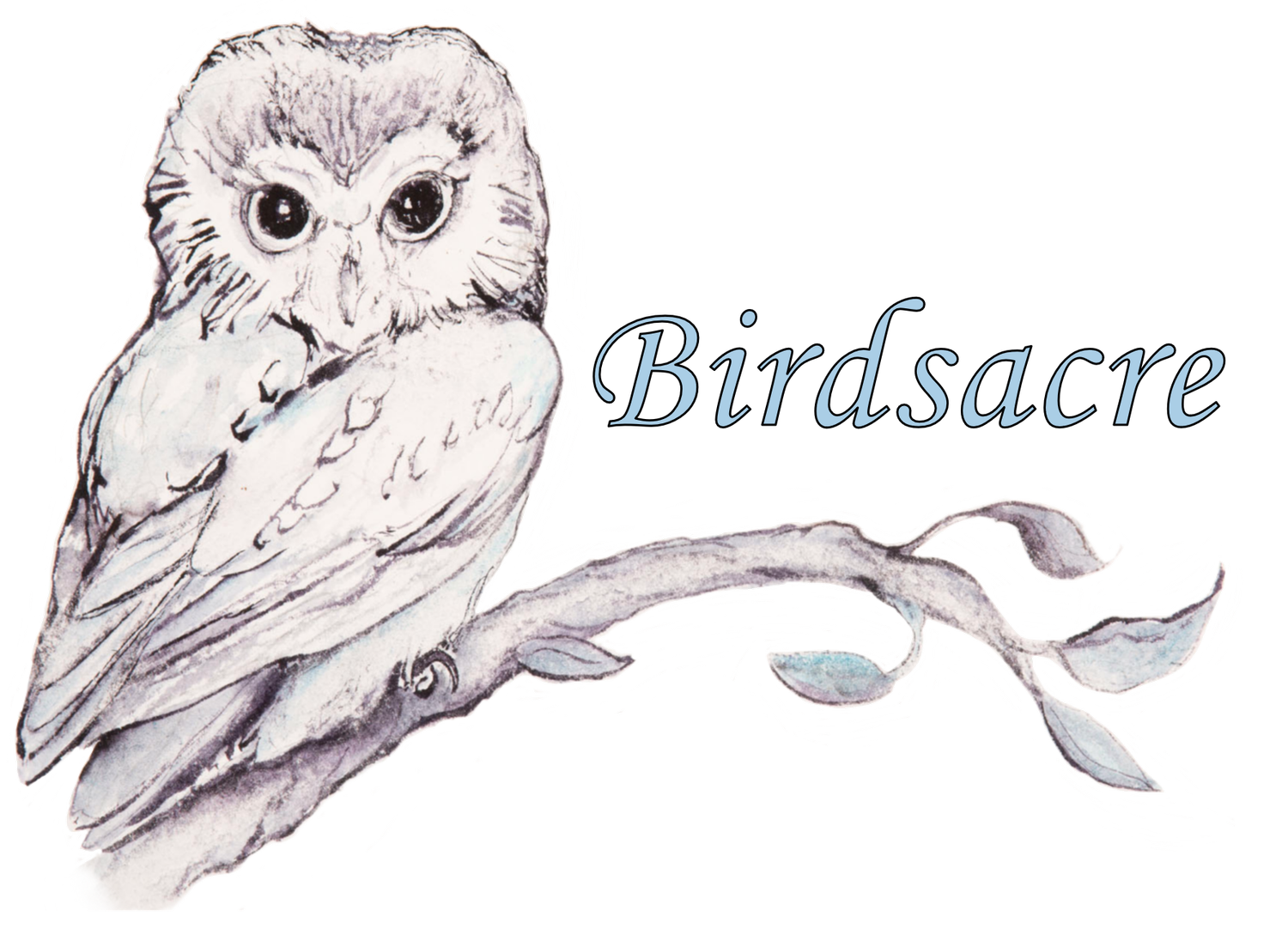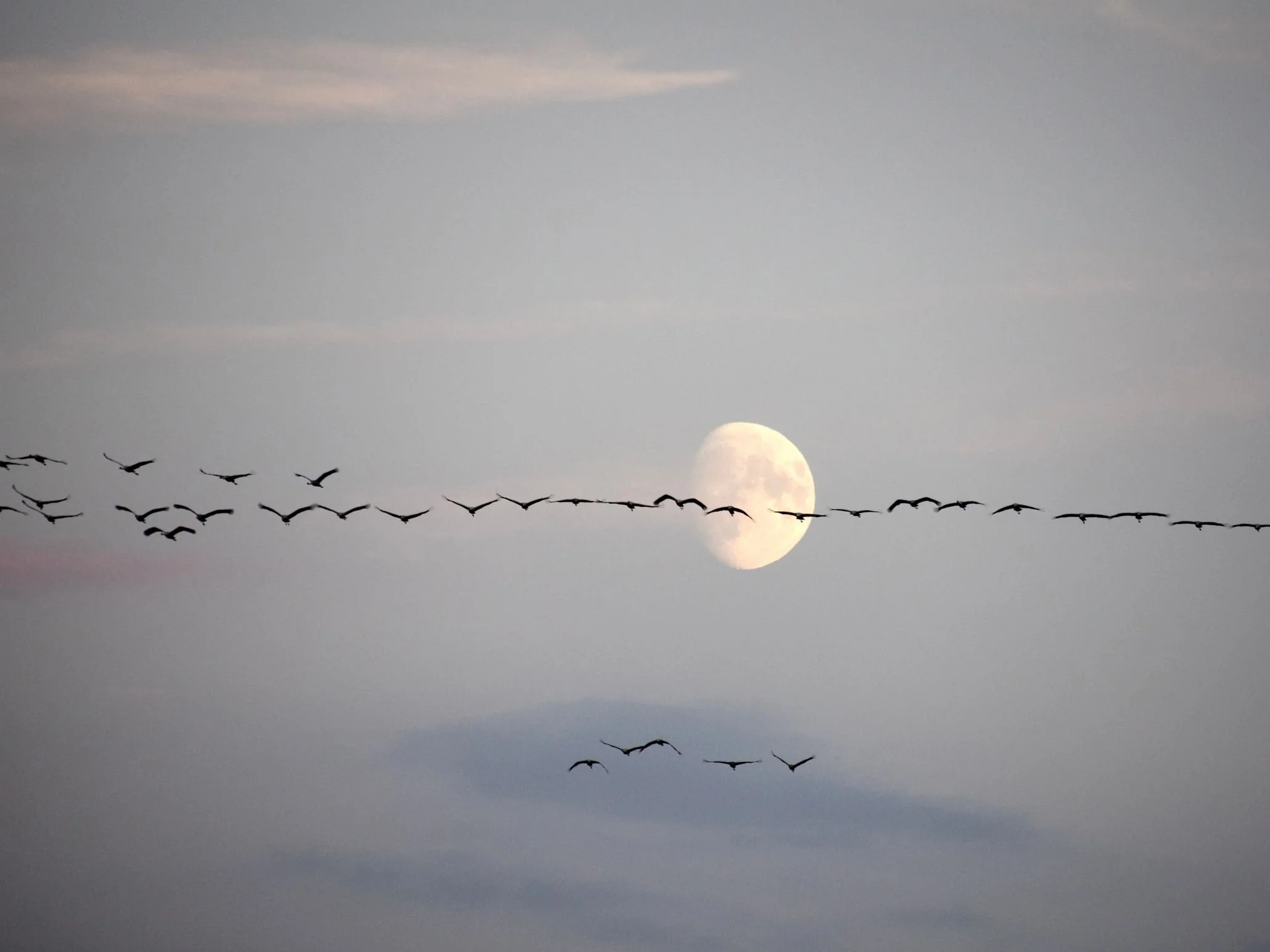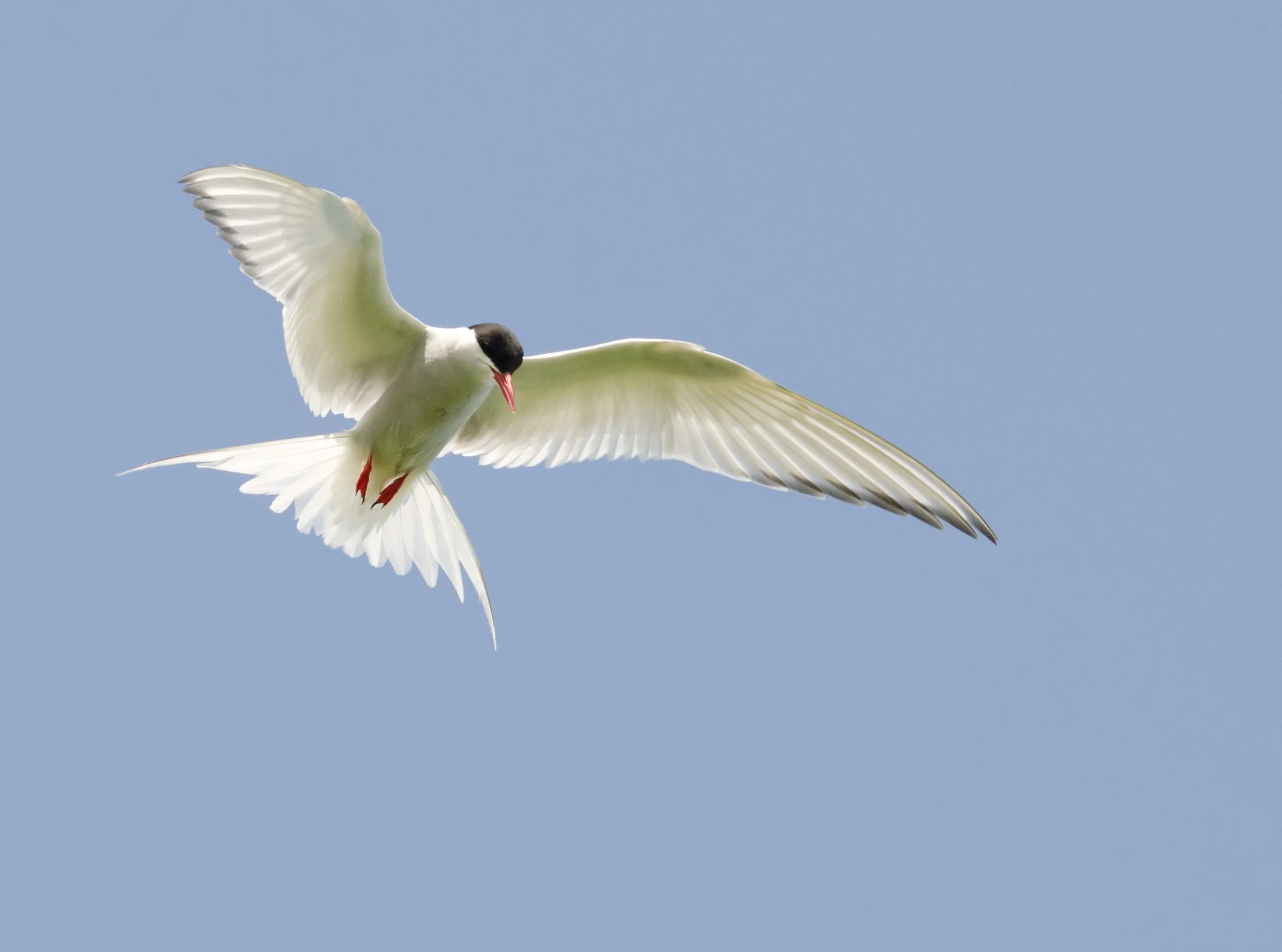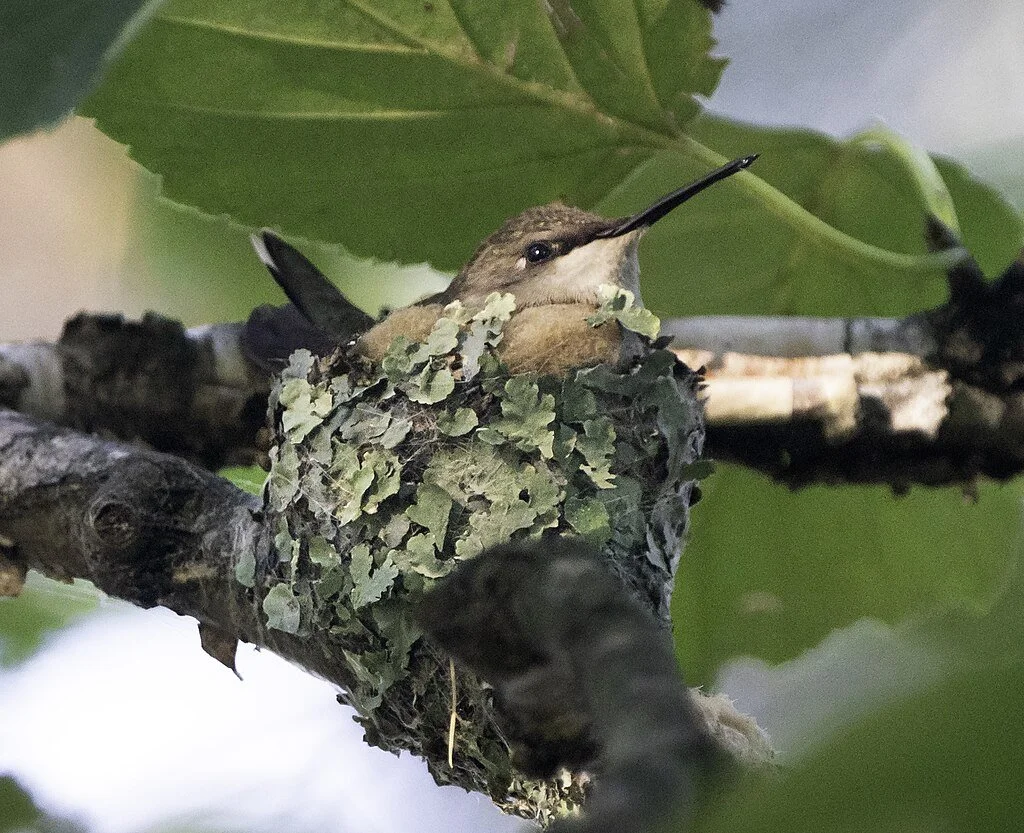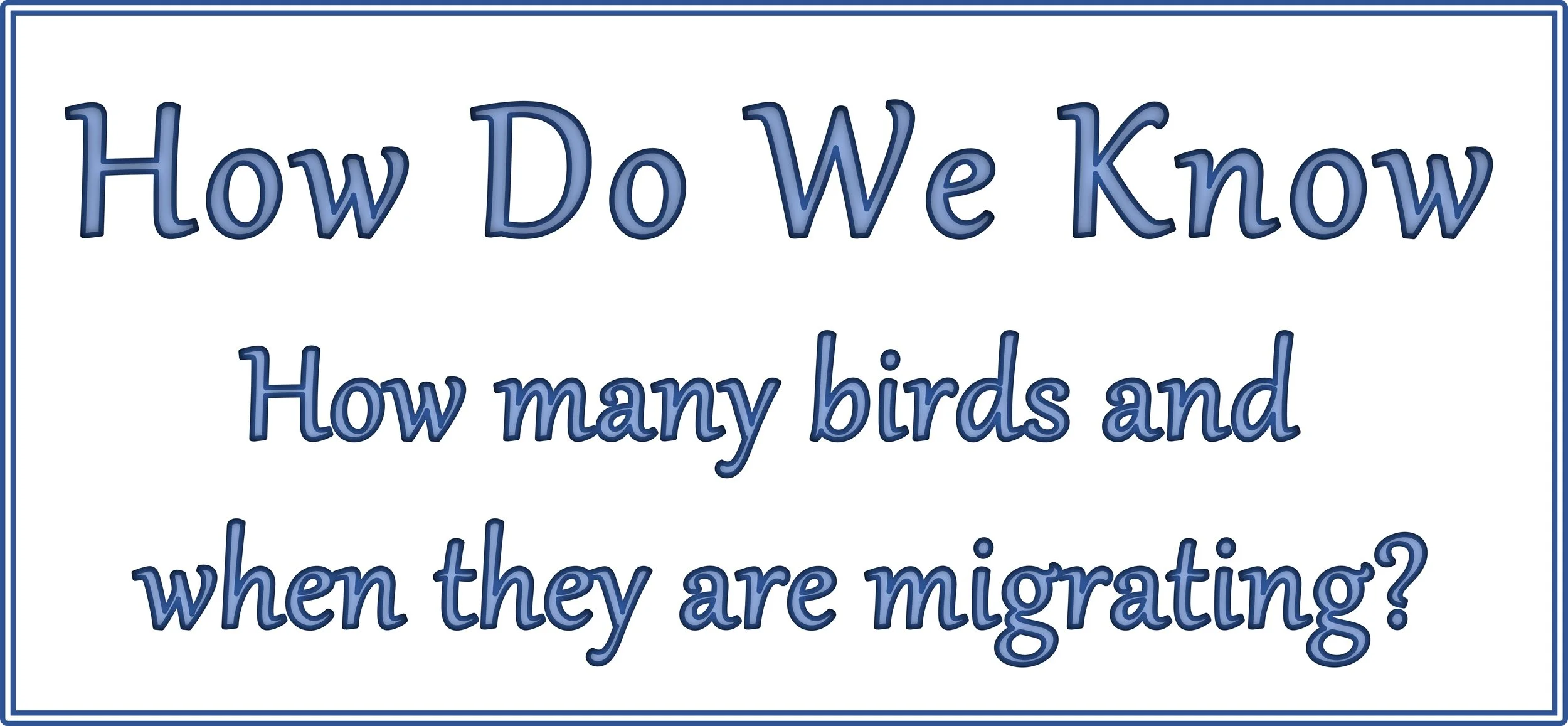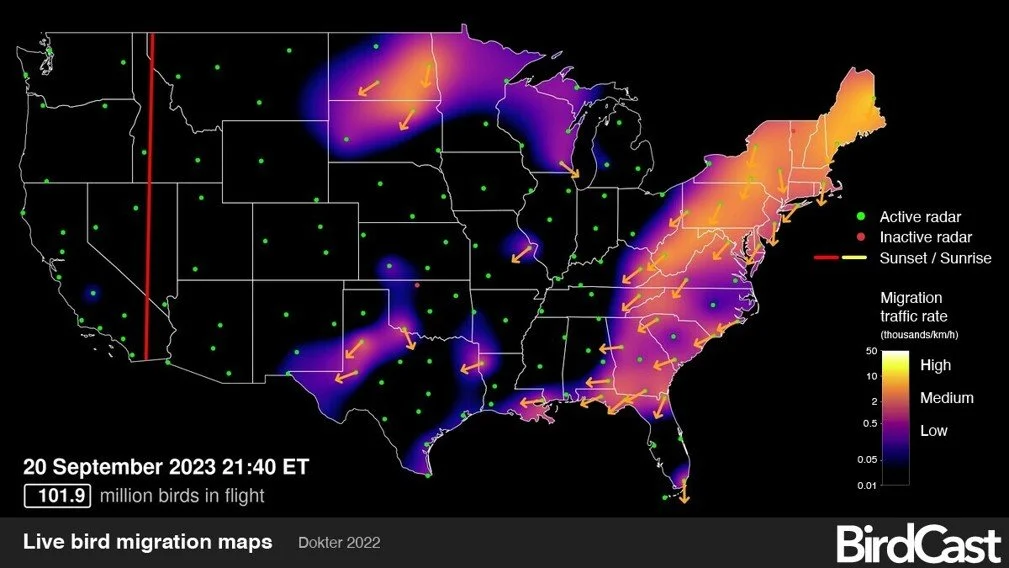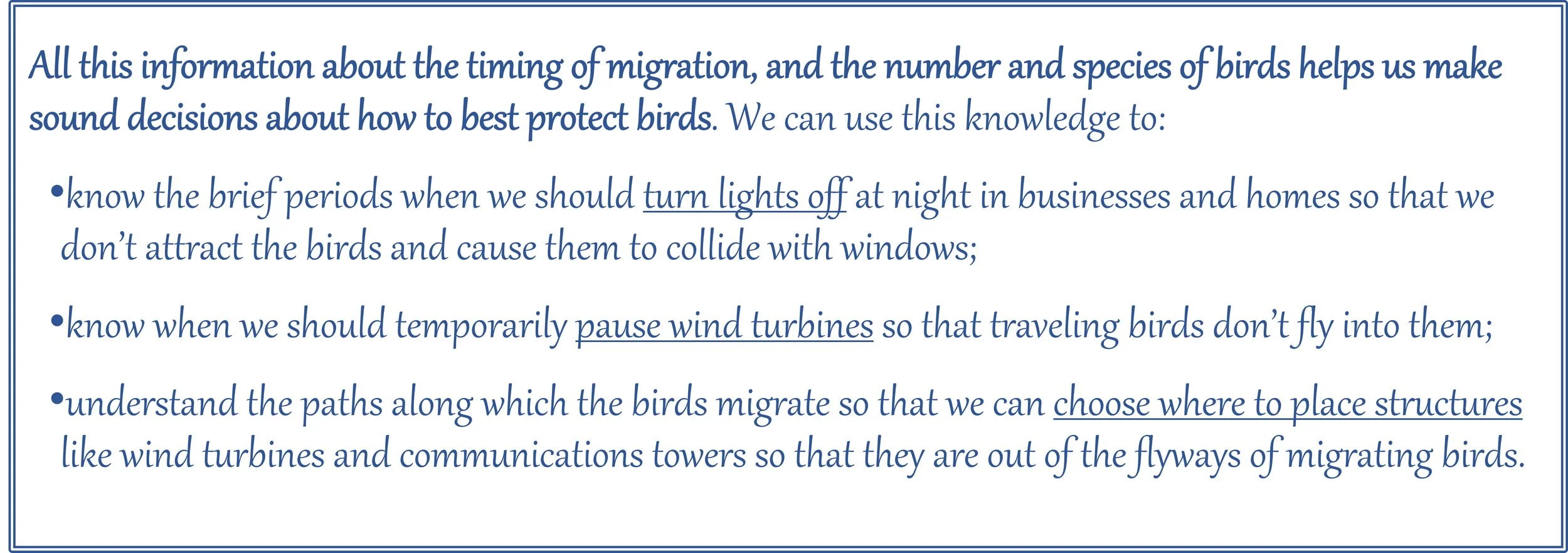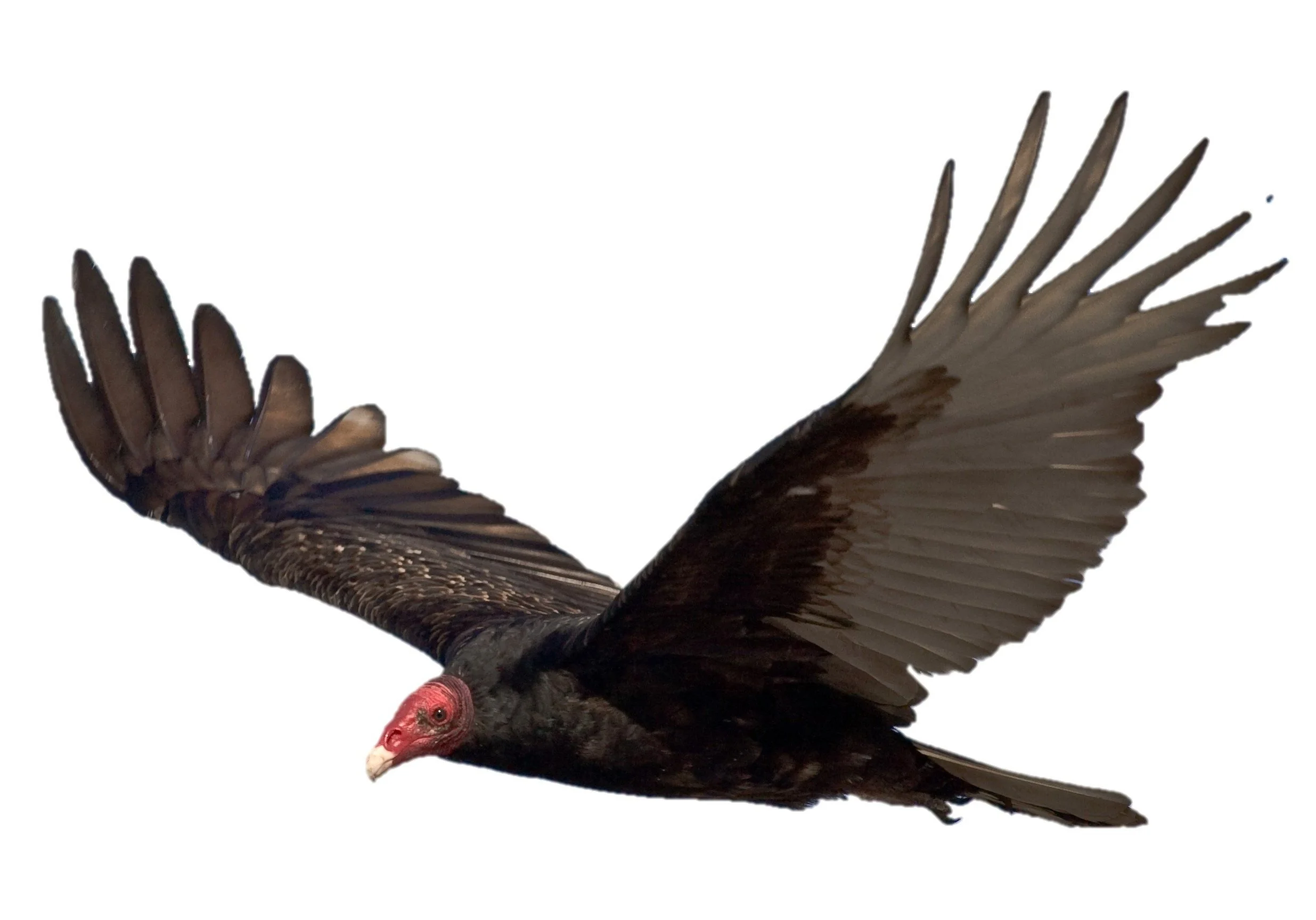Scientists – and birders – use weather radar to track migrating birds. Just like precipitation and water vapor, birds (and insects) reflect radar beams. Researchers can distinguish between weather, bird, and insect reflections. They can use weather surveillance radar to measure the density of a mass of birds and then translate this into the number and movement of birds in flight. Ground recordings help identify specific species of birds in flight!
This information is verified by visual and sound observations made by researchers and birders on the ground, by monitoring movement of known banded birds, and by carefully capturing, banding, and releasing migratory birds along their journey.
This amazing map is a snapshot of intensities of fall bird migration detected by the US weather surveillance radar network on September 20, 2023 at 9:40 pm.
102 million birds were estimated to be in flight at that moment, migrating to the south from their northern breeding grounds to their more southern winter grounds.
The brightest colors represent the highest number of birds in flight; cooler, darker colors represent lower numbers of migrating birds. Arrows show the direction of movement. You can see maps like this showing real-time migration during the fall and spring and learn more at https://birdcast.info/migration-tools/.
A researcher gently removes a Chipping Sparrow from a mist net that was put in place to safely capture a sample of birds moving through the area. The Sparrow will be carefully – and quickly - examined, measured, and banded before letting it go back on its way.
A researcher examines and records the condition of feathers of a captured bird before she releases it to the wild.
A Common Yellowthroat Warbler receives a lightweight leg band with unique numbers that will allow this bird to be identified in the future. The band will not inhibit its flight or movements.
This graph shows the estimated total number of birds (green line) that had crossed Maine during fall migration by September 20, 2023, compared to the estimated total across Maine for the migratory season (gray). The curve rises quickly during peak of migration and levels off at the end of the season in November. You can see the current numbers in the BirdCast Dashboard for Maine – or other regions that interest you: https://dashboard.birdcast.info/region/US-ME.
Explore Further!
Check out BirdCast during spring and fall migration to get daily updates on migration in your area! Learn when migration peaks are predicted, which species are migrating through, and watch live migration maps.
Learn about the individual birds, their migration paths, and some of the challenges they face using the National Audubon Society’s Bird Migration Explorer.
Read or listen to A World on the Wing: The Global Odyssey of Migratory Birds, by Scott Weidensaul (2022, Picador; Main Market, 385p.). A soaring exploration of our current understanding of bird migration - the immense distances flown twice yearly, the physical adaptations that fuel these journeys, the challenges faced, and our growing awareness and conservation support.
Learn more about ways you can support birds and their migration, from cats to coffee (yes, coffee!) to windows to habitat to citizen science to who to tell birds matter to you!
Cornell Lab of Ornithology’s Seven Simple Actions to Help Birds provides concrete actions you can take to help birds every day. If you want more ideas, check out Cornell Lab’s list of ten!
The American Bird Conservancy’s Migratory Bird pages offer an in-depth exploration of migration, challenges, and ways you can help support migratory birds and advocate for their needs.
References and Image Credits
Magnificent Migration
Broad-Winged Hawks (Buteo platypterus). Rhododendrites, CC BY-SA 4.0, via Wikimedia Commons. https://commons.wikimedia.org/wiki/File:Broad-winged_hawks_(46962).jpg.
Garganey (Spatula querquedula), Thrissur District, Kerala. Rison Thumboor from Thrissur, India, CC BY 2.0, via Wikimedia Commons. https://commons.wikimedia.org/wiki/File:Flock_of_Garganey,_Thrissur_District,_Kerala_(23444352746).jpg.
Migrant birds and Moon. Frerk Meyer from Buchholz in der Nordheide, Niedersachsen, CC BY-SA 2.0, via Wikimedia Commons. https://commons.wikimedia.org/wiki/File:Zugv%C3%B6gel_-_Migrant_bird_and_Moon_-_Flickr_-_greenoid.jpg.
Murmuration of Starlings (Sturnus vulgaris), Ham Wall Reserve. Rupert Fleetingly, CC BY-SA 2.0, via Wikimedia Commons. https://commons.wikimedia.org/wiki/File:Murmuration,_Ham_Wall_-_geograph.org.uk_-_2249794.jpg.
Four Canada Geese (Branta canadensis) flying to a farmer’s field near Chilliwack, British Columbia,Canada. Terence Starr, CC BY-SA 4.0, via Wikimedia Commons. https://commons.wikimedia.org/wiki/File:4_Flying_Geese.jpg.
Two of an estimated one thousand Broad-Winged hawks (Buteo platypterus), Lower Rio Grande Valley. Gregory "Slobirdr" Smith, CC BY-SA 2.0, via Wikimedia Commons. https://commons.wikimedia.org/wiki/File:Broad-winged_Hawk_(Buteo_platypterus)_(51154306647).jpg.
Arctic Tern (Sterna paradisaea) over Inner Farne. Darrel Birkett from Lanchester, Co Durham, CC BY 2.0, via Wikimedia Commons. https://commons.wikimedia.org/wiki/File:Sterna_paradisaea_-Inner_Farne,_Farne_Islands,_Northumberland,_England_-flying-8.jpg.
Willets (Tringa semipalmata), Marbled Godwits (Limosa fedoa) and unidentified dowitchers (Limnodromus species) at Arrowhead Marsh, Oakland, California. Ingrid Taylar from San Francisco Bay Area - California, USA, CC BY 2.0, via Wikimedia Commons. https://commons.wikimedia.org/wiki/File:Shorebirds_01.jpg.
A Turkey Vulture (Cathartes aura) flying in Morro Bay, California, USA. "Mike" Michael L. Baird, CC BY 2.0, via Wikimedia Commons. https://commons.wikimedia.org/wiki/File:Cathartes_aura_-Morro_Bay,_California,_USA_-flying-8b.jpg.
Arctic Tern (Sterna paradisaea) with chick. Jaan Künnap, CC BY-SA 4.0, via Wikimedia Commons. https://commons.wikimedia.org/wiki/File:Randtiir_(Sterna_paradisaea)._Vaindloo_saar_(Juuni_2023)_(05).jpg.
Ruby-Throated Hummingbird (Archilochus colubris). jeffreyw, CC BY 2.0, via Wikimedia Commons. https://commons.wikimedia.org/wiki/File:Archilochus_colubris_-_by_jeffreyw_-_004.jpg.
A female Ruby-throated hummingbird on nest in Aitkin, Minnesota, Lorie Shaull, CC BY-SA 4.0 <https://creativecommons.org/licenses/by-sa/4.0>, via Wikimedia Commons. https://commons.wikimedia.org/wiki/File:Ruby-throated_hummingbird_on_nest_05.jpg.
Piping plover (Charadrius melodus) chick on the beach in Queens, New York City. Rhododendrites, CC BY-SA 4.0, via Wikimedia Commons. https://commons.wikimedia.org/wiki/File:Piping_plover_chick_(93850).jpg.
A male American Kestral (Falco sparverius) at Canadian Raptor Conservancy, Canada, Vince Maidens, CC BY 2.0, via Wikimedia Commons. https://commons.wikimedia.org/wiki/File:Falco_sparverius_-Canadian_Raptor_Conservancy,_Canada_-flying-8a.jpg.
Eurasian Kestrel (Falco tinnunculus) juveniles on nest, Czech Republic, Bohuš Číčel (https://www.flickr.com/photos/bcicel/), CC BY-SA 3.0, via Wikimedia Commons. https://commons.wikimedia.org/wiki/File:Falco_tinnunculus_1_(Bohu%C5%A1_%C4%8C%C3%AD%C4%8Del).jpg.
A snowy owl (Bubo scandiacus) flying over tundra, Bert de Tilly, CC BY-SA 3.0, via Wikimedia Commons. https://commons.wikimedia.org/wiki/File:Snowy-Owl.1.jpg.
A pair of Tree Swallows (Tachycineta bicolor) in flight at Jamaica Bay Wildlife Refuge, Queens. Ant.tab, CC BY-SA 4.0, via Wikimedia Commons. https://commons.wikimedia.org/wiki/File:Tree_Swallows,_Jamaica_Bay_Wildlife_Refuge,_Queens,_New_York_2022.jpg.
Tracking Migration
Flocks of snow geese (Chen caerulescens) can number in the tens to hundreds of thousands when they are migrating. These birds in the Kulm Wetland Management District take off, fly, whirl, and re-settle in fields to feed and rest, or in wetlands to roost for the night. The flock keeps up a raucous cackle and noise that travels for miles in good conditions and fills the air with the sounds of Spring! Photo Credit: Krista Lundgren/USFWS USFWS Mountain-Prairie, CC BY 2.0 <https://creativecommons.org/licenses/by/2.0>, via Wikimedia Commons. https://commons.wikimedia.org/wiki/File:A_Sky_Full_of_Snow_Geese_(16872274985).jpg.
Map of live migration on September 20, 2023 at 9:40 pm. Dokter, A. M., BirdCast, live migration map, Cornell Lab of Ornithology. https://birdcast.info/migration-tools/migration-forecast-maps.
A researcher gently removing a Chipping Sparrow from a mist net. NPS / Jacob W. Frank, Yellowstone National Park, Public domain, via Wikimedia Commons. https://commons.wikimedia.org/wiki/File:Yellowstone_Bird_Program_(2)_Biological_Science_Technician_Mary_Beth_Albrechtsen_takes_a_chipping_sparrow_out_of_the_net_(48804073353).jpg.
A woman holding a small bird in her hand and taking measurements of its wing size. English: NPS Photo / Emily Mesner, Public domain, via Wikimedia Commons. https://commons.wikimedia.org/wiki/File:An_avian_ecologist_collects_data_from_a_bird_captured_near_the_park_entrance_on_May_31,_2019._(76e88fa2-7e09-4f6b-b2b8-880b87fb8db6).JPG.
A researcher uses banding pliers to attach a band to the leg of a Common Yellowthroat at a bird banding station at Murphy-Hanrehan Park Reserve in Savage, Minnesota. The bird was captured in a mist net. Lorie Shaull, CC BY-SA 4.0 <https://creativecommons.org/licenses/by-sa/4.0>, via Wikimedia Commons. https://commons.wikimedia.org/wiki/File:A_researcher_uses_a_banding_pliers_to_attach_a_band_to_the_leg_of_a_Common_Yellowthroat.jpg.
Birds migrating across Maine on September, 20, 2023, https://dashboard.birdcast.info/region/US-ME?night=2023-09-20.
